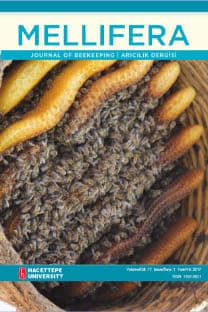A New Record for Propolis Substitute: Pruning Sealer
Propolis, Pruning sealer, Chemical analysis,
___
- [1] CHRISTOV, R; TRUSHEVA, B; POPOVA, M; BANKOVA, V; BERTRAND, M (2006) Chemical composition of propolis from Canada, its antiradical activity and plant origin. Natural product research, 20(06), 531-536.
- [2] MACHADO, B ; PULCİNO, T N ; SİLVA, A L ; TADEU, D; MELO, R G S; MENDONÇA, I G (2017) Propolis as an alternative in prevention and control of dental cavity. Immunity, 19, 24.
- [3] DUKE, C C; TRAN, V H; DUKE, R K; ABU-MELLAL, A; PLUNKETT, G T; KING, D I; ... BRUHL, J J; (2017) A sedge plant as the source of Kangaroo Island propolis rich in prenylated p-coumarate ester and stilbenes. Phytochemistry, 134, 87-97.
- [4] TRAN, V H; DUKE, R K; ABU-MELLAL, A; DUKE, C C (2012) Propolis with high flavonoid content collected by honey bees from Acacia paradoxa. Phytochemistry, 81, 126-132.
- [5] GHISALBERTI, E (1979) Propolis: a review. Bee world, 60(2): 59-84.
- [6] SORKUN, K (2008) Türkiye'nin nektarlı bitkileri, polenleri ve balları.Palme Yayıncılık.
- [7] REVILLA, I; VIVAR-QUINTANA, A M; GONZÁLEZ-MARTIN, I; ESCUREDO, O; SEİJO, C (2017) The potential of near infrared spectroscopy for determining the phenolic, antioxidant, color and bactericide characteristics of raw propolis. Microchemical Journal, 134, 211-217.
- [8] KORKMAZ, A (2013) Anlaşılabilir Arıcılık. Samsun Gıda Tarım ve Hayvancılık İl Müdürlüğü Yayını
- [9] DE CASTRO, S (2001) Propolis: biological and pharmacological activities. Therapeutic uses of this bee-product. Annu Rev Biomed Sci, 3: 49-83.
- [10] FOKT, H; PEREIRA, A, FERREIRA, A M; CUNHA, A; AGUİAR, C (2010) How do bees prevent hive infections? The antimicrobial properties of propolis. Current Research, Technology and Education Topics in Applied Microbiology and Microbial Biotechnology, 1, 481-493.
- [11] NYEIN, M (1983) The use of asphalt as a propolis substitute. AMERICAN BEE JOURNAL, 123(10)732-732.
- [12] ALQARNI, A S; RUSHDI, A I; OWAYSS, A A; RAWEH, H S; EL-MUBARAK, A H; SIMONEIT, B R (2015) Organic Tracers from Asphalt in Propolis Produced by Urban Honey Bees, Apis mellifera Linn. PloS one, 10(6), e0128311.
- [13] POPOVA, M P; BANKOVA, V S; BOGDANOV, S; TSVETKOVA, I; NAYDENSKI, C; MARCAZZAN, G L; SABATINI, A G (2007) Chemical characteristics of poplar type propolis of different geographic origin. Apidologie, 38(3), 306-311.
- [14] PubChem: a public information system for analyzing bioactivities of small molecules: available from: https://pubchem.ncbi.nlm.nih.gov/.
- ISSN: 1302-5821
- Yayın Aralığı: 3
- Başlangıç: 2001
- Yayıncı: Hacettepe Üniversitesi
Çiğdem ÖZENİRLER, Ömür Gençay ÇELEMLİ, Nazlı MAYDA, Kadriye SORKUN
Importance of Nutrition for Honey Bee Health
Harun METİN, Talip ÇETER, Seher KARAMAN ERKUL
Kethula MAMATHA, Ravula DEVENDER, Jangam Ganga KAILASH, Sonte NIRANJA, Hari RAMAKRISHNA
Kethula MAMATHA, Ravula DEVENDER, Jangam Ganga KAILASH, Sonte NIRANJA, Hari RAMAKRISHNA
Harun METİN, Talip ÇETER, Seher KARAMAN ERKUL
A New Record for Propolis Substitute: Pruning Sealer
Çiğdem ÖZENİRLER, Ömür Gençay ÇELEMLİ, Nazlı MAYDA, Kadriye SORKUN
